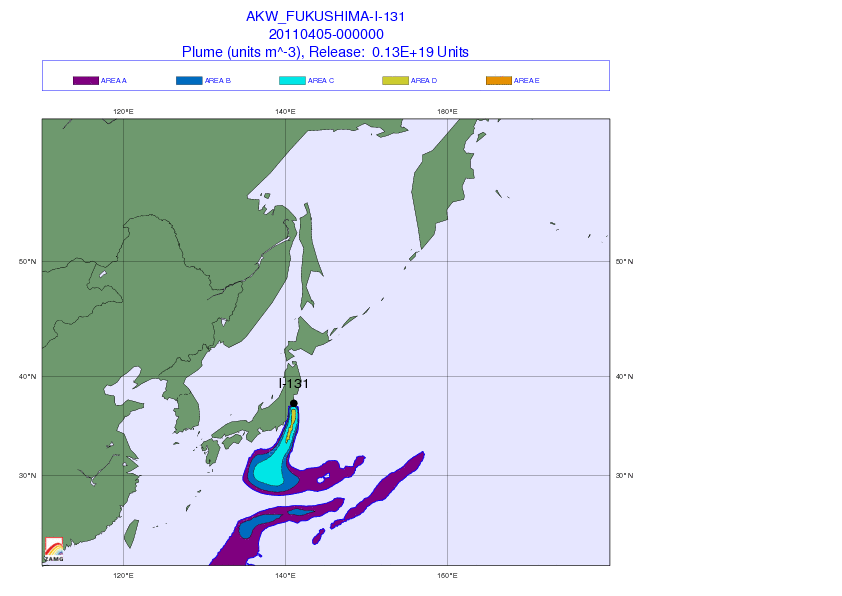As Zero Hedge noted yesterday:
As the following animation from ZAMG demonstrates, courtesy of Northeastern winds, a major cloud of radioactive Iodine 131 is currently passing right over South Korea. Making matters worse is the fact that it is currently drizzling in the landlucklocked nation, putting people on edge....
More from Arirang:
***
The weather agency's spokesman Kim Seung-bae said at a briefing held on Wednesday, that air current analysis shows that the winds blowing from the island nation will circle clockwise and fade out towards the Pacific Ocean by Friday, leaving the Korean peninsula unaffected.
Officials added, however, they will step up monitoring traces of radioactive materials throughout Korea and especially on Jeju Island, since it will be hit before any other regions if the winds unexpectedly blow towards Korea.
As Reuters notes today, South Koreans don't trust their government's assurances of safety:
In South Korea, some schools closed because parents were worried that rain across the country could be toxic.
"We've sent out an official communication today that schools should try to refrain from outdoor activities," an education official in South Korea said.
South Korea's nuclear safety agency reported a small level of radioactive iodine and caesium particles in rain in the south but said it was not enough to be a public health concern.
Nevertheless, many Koreans donned face masks, and streets near schools in Seoul were more congested than usual as parents drove children to work rather than let them walk.
While gas masks might be a little over-the-top, it's hard to fault the South Koreans from being a little worried, given that there are no "safe" levels of radiation (and see this) and that the Japanese government has not exactly been forthcoming about the nuclear crisis.

Looks like China has a weather machine too!
ReplyDeleteDon't "HARP" on that comment!
ReplyDeletemick
There may not be a "safe" level of radiation exposure, but since natural radiation exposure varies from place to place, surely additional radiation that's only a fraction of natural exposure is no cause for concern.
ReplyDeleteWhat amazes me is that citizens in the US still insist on believing their government.
ReplyDeleteNo safe levels. Amen. I'm not being insincere. I am very risk averse, so I go to efforts to understand the risks.
ReplyDeleteI'm not being sardonic. I canceled a recent dental cleaning here because the dentist refuses to forgo an annual x-ray.
And an annual dental x-ray is usually not that much, if they have newer equipment.
Look at this list, folks, and recognize your own significant radiation exposures. You are getting radiation. Knowledge is easy since it's been simplified by researchers into a very clear form. From the wiki on Sievert.
Single (sudden) dose levels:
Dental radiography: 0.005 mSv[3]
Average dose to people living within 16 km of Three Mile Island accident: 0.08 mSv during the accident[4]
Mammogram: 3 mSv[3]
Brain CT scan: 0.8–5 mSv[5]
Chest CT scan: 6–18 mSv[5]
Gastrointestinal series X-ray investigation: 14 mSv[6]
International Commission on Radiological Protection recommended limit for volunteers averting major nuclear escalation: 500 mSv[7]
International Commission on Radiological Protection recommended limit for volunteers rescuing lives or preventing serious injuries: 1000 mSv[7]
Now, some of your own inevitable dose levels:
Ongoing yearly accumulation dose levels:
Dose from living near a nuclear power station: 0.0001–0.01 mSv/year[6][8]
Dose from living near a coal-fired power station: 0.0003 mSv/year[8]
Dose from sleeping next to a human for 8 hours every night: 0.02 mSv/yr[8]
Dose from Cosmic radiation (from sky) at sea level: 0.24 mSv/year[6]
Dose from Terrestrial radiation (from ground): 0.28 mSv/year[6]
Dose from Natural radiation in the human body: 0.40 mSv/year[6]
Dose from standing in front of the granite of the United States Capitol building: 0.85 mSv/year[14]
Average individual background radiation dose: 2 mSv/year; 1.5 mSv/year for Australians, 3.0 mSv/year for Americans[8][4][9]
Dose from atmospheric sources (mostly radon): 2 mSv/year[6][15]
Total average radiation dose for Americans: 6.2 mSv/year[16]
New York-Tokyo flights for airline crew: 9 mSv/year[9]
Dose from smoking 30 cigarettes a day Smoking: 13-60 mSv/year[14][15]
Current average dose limit for nuclear workers: 20 mSv/year[9]
Dose from background radiation in parts of Iran, India and Europe: 50 mSv/year[9]
Dose limit applied to workers during Fukushima emergency: 250 mSv/year[17]
American background cancer rate: your odds of death by cancer currently at about 42/100, or 42%.